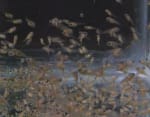 To meet the demand for tilapia fingerlings, more private hatcheries should be established. Although some fish-farmers specialize in fingerling production, many of them are engaged in fingerling and food fish production simultaneously. As the industry expands, farmers realize the importance of using good quality fingerlings. As long as the demand for fingerlings exists, a well-managed hatchery is a lucrative business.
To meet the demand for tilapia fingerlings, more private hatcheries should be established. Although some fish-farmers specialize in fingerling production, many of them are engaged in fingerling and food fish production simultaneously. As the industry expands, farmers realize the importance of using good quality fingerlings. As long as the demand for fingerlings exists, a well-managed hatchery is a lucrative business.
Brood Stock Selection
Genetic improvement of tilapia is imperative to the development of the industry. Select quality brood stock to improve tilapia production. Choose pure quality stocks and do not allow them to crossbreed with other species to preserve their genetic quality. Tilapia farmers should buy their stocks only from reliable and established sources.
Maintenance of Good Quality Stock
It is necessary to maintain high quality pure stock with the following measures:
1. Prevent the introduction of inferior tilapia species into the brood ponds. Filter all incoming water or use ground water, if possible
2. Use brood fish of about 100 g or more. If larger brood stock are used the original stock can be easily identified after each production cycle. Use the same stock repeatedly, depending on their performance.
3. Adopt an independent culling-selection process for undesirable stock. Always eliminate fish that has questionable characteristics
4. Examine breeders carefully when re-stocking after each cycle.
5. Avoid introduction of breeders from non-accredited sources.
6. Teach laborers and caretakers the importance of preventing genetic contamination.
7. Drain ponds completely and remove all stocks pond reconditioning.
Hatchery Methods
Pond Method
The open pond is the simplest and most common method of fingerling production. In this method, a pond serves both for spawning and rearing. Stock breeders into the ponds and allow to spawn naturally at controlled conditions.
Brood fish stocking rate. Stock pond at the rate at 100 to 200 kg brood stock per hectare at a sex ratio of 1:3 or 1:4 male to female. Brood only fish weighing about 50-100 g. A female brood fish of 90-300 g produces as much as 500 eggs per spawning. However, brood fish may be used continuously for a period of 3-5 years. Use larger breeders to identify them as brood stock.
Collecting, grading and conditioning fingerlings. Collect fingerlings 30-45 days after stocking of breeders using knot 32 mesh seine. Do this 3-4 times per harvest period at an interval of two to four weeks.
Grade collected fingerlings by using 22k, 17k, 14k and 10k nets. Release breeders back to the pond immediately. Condition collected fingerlings by stocking these in “hapa” or tanks for 3 or more days before disposal. Give the fingerlings supplementary feeds at the rate of 3% body weight. However, stop feeding 24 hours prior to disposal. The ideal stocking rate for ‘hapa” is 2-3 kg of fingerlings per cubic meter.
The average number of fingerlings harvested should be at least 100,000 pieces per hectare per month or about 1.2 million per hectare per year. Increasing the frequency of harvesting and minimize predation and cannibalism by the parent fish and other predators of the fingerlings.
Recondition the ponds after 120 days or sooner to increase production.
Restock small fingerlings in earth nurseries to reach the desired size of size 22 at 15-30 days and size 17 at 45 days. Stocking rates between 25 to 30 fingerlings per square meter give optimum results.
Routine hatchery pond fertilization. Aside from the basal fertilization, apply organic fertilizer uniformly such as air-dried chicken dung at the rate of 750 kg/ha per week or 3 tons/ha per month.
Apply inorganic fertilizers (16-20-0) at the rate of 100 kg/ha per month. New ponds may require higher rates of fertilizers.
Increase the rate of fertilizer if plankton bloom does not appear within 5-10 days. Apply fertilizer by means of the platform or by the hanging sack method.
Feeding. If manure is not applied, use supplemental feeding feed fish with rice bran at the rate of 2-3% of their body weight per day. Give 1/2 of the daily ration in the morning and the other half in the afternoon. Drain the pond completely after 90-120 days to eliminate predators and prevent inbreeding. To prepare the pond for the next production cycle, refer to “Fishpond Preparation”.
Advantages of the Open Pond
* management is very simple, but effective
* the pond serves as spawning and rearing pond, thus, the fingerlings produced are larger compared to those produced through the other methods
No supplemental feeding is required at high manuring rates
Disadvantages of the Open Pond
* the number of fingerlings produced per square meter is lesser compared with the other methods
* the fingerlings produced are not of the same size; they need to be graded upon harvesting.
“Hapa” Method
A “hapa” (net enclosure or “bitinan”) is like an inverted mosquito net which the four top corners are tied to bamboo stakes. It is made of fine meshed polyethelene netting. The seams are sewn with nylon thread and double stitched to prevent splitting.
A “hapa”, measuring 3 m long , 3 m wide and 1.5 m deep is the most common size used. Usualy, it is installed in ponds, lakes or along river banks with slow moving current. The open part of the “hapa” should be two feet above the water surface.
Advantages of the Open Pond
* production on a per square meter basis is high
* fry are more uniform in size
* fry and breeders are easily handled
Disadvantages of the Open Pond
* management is more complicated and intense compared with the other methods
* brood fish in “hapa” are easy targets of poachers
* “Hapas” may be destroyed or blown away during typhoon or stormy weather
* feeding of breeders and fry is a must
Stocking. In the “hapa” method, the sex ratio of male to female is 1:5 to 1:7. Stock 4-5 breeders weighing 50 to 200 g pe sq m.
Feeding. Feeding is a must in the “hapa” daily for the presence of schooling fry. Two weeks stocking of breeders, scoop out fry and transfer these to tanks, other “hapas” or rearing pond. Feed collected fry a diet in powdered form at the rate of 5 percent of the total body weight.
Collecting fry. Check the “hapa” daily for the presence of schooling fry. Two weeks after stocking of breeders, scoop out fry and transfer these to tanks, other “hapas” or rearing ponds. Feed collected fry a diet in powdered form at the rate of 5 percent of their body weight per day. Feed four times a day until they reach the desired size.
Source: da.gov.ph
Do you like this business ideas? then please consider subscribing to our PINOY BISNES ![]() RSS feed. You can also subscribe by email and have new business ideas sent directly to your inbox. (Once you entered your e-mail address, you need to login to your e-mail account and click the link to confirm your subscription).
RSS feed. You can also subscribe by email and have new business ideas sent directly to your inbox. (Once you entered your e-mail address, you need to login to your e-mail account and click the link to confirm your subscription).




hi need more information about red tilapia hatchery. thanks